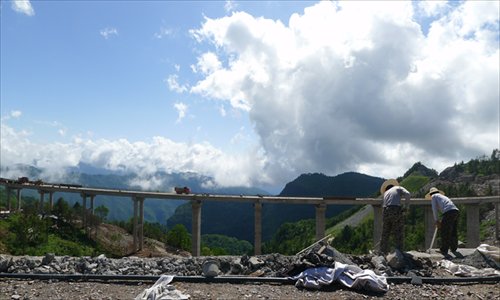

Two workers work at the construction site of the airport in Shennongjia, Hubei Province on June 25. Photo: Liu Dong/GT
Zhang Wei (pseudonym) has been waiting at a crossroads for an hour. Finally, a truck loaded up with sand rumbles into sight. Zhang stamps out his cigarette on the ground immediately and waves in the middle of the road for attention. He is trying to get a lift into the deep mountains in Shennongjia, where he knows there is a big money-making scheme.
Zhang was a professional electric welder back in his hometown of Shiyan, a city close to the nature reserve of Shennongjia in China's central Hubei Province. After a five-hour bus ride, he arrived in this sparsely populated region. He is trying to find a job at an airport construction site atop a local mountain at a height of more than 2,500 meters.
As a national 5A-Class Scenic Spot, the country's highest official scenic spot boasts a vast rainforest, thousands of flora and fauna, including the elusive golden monkey, and marks the southern water intake for the vast "South-to-North Water Diversion Project." UNESCO added Shennongjia to its World Network of Biosphere Reserves in 1990.
However, with news of the airport becoming public, concerns about its ecological impact on the forest region have been increasingly discussed. Above all, the major question from the public and the media is why the authorities failed to present the project's environmental impact assessment report to the public.
Taking shape
This is not the first time Zhang has been here. Several months ago, he was told about the job by a neighbor who already worked up there and informed him more hands were needed for the giant project with its deadline looming.
Zhang happily accepted the invitation and hurried to the construction site but what he found there was beyond his expectations.
"I didn't know they were building an airport at a height of 2,580 meters up a mountain. That was a real eye-opener," Zhang told the Global Times.
But Zhang didn't stay up there for long due to the weather. "It was freezing in January, the temperature could drop as low as 20 degrees below zero and we were shivering in the wind and snow," he said.
Returning home, Zhang planned to try his luck again when the weather turned more clement and as time began to run out.
When Zhang finally returned to the mountaintop in June, an airport could be seen taking shape. The number of workers was also significantly down from the 2,000 he had seen during his last visit. Zhang found a job as a welder working in the airport terminal building. He was told if he applied himself, he could make 5,000 yuan by the end of July.
However, this airport project was not known by the public until recently when local media reported it would begin to run trial flights this October.
The airport, designed to handle 250,000 visitors and 1,000 tons of cargos annually by 2020, is estimated to cost 1.04 billion yuan ($170 million) in investment and will be the highest airport in central China.
According to Wuhan Evening News, the construction work officially started in April 2011, removed five mountaintops and filled in hundreds of caves to build the airport's foundations. It was reported builders used more than 3 million tons of explosives to excavate a highway through the mountains.
Public information from the local government shows Shennongjia airport was listed as one of 12 major projects on its work agenda to build an ecological and cultural tourism zone in western Hubei Province back in 2009.
"The difficulty of building such an airport is rare in the history of China," Tang Xie, director of the airport's project office told the Global Times. He also added that the mountains removed were actually 60-meter high hills. "Technically, they are not mountaintops," he said, adding that the project had included reforestation and environment restoration work to maintain the local ecology.
Economic growth engine
In fact, Shennongjia government has long waited for this airport due to an embarrassing reality - though it is rich in ecological resources, Shennongjia is one of China's most poverty-stricken areas.
According to public information, Shennongjia's 2012 GDP figure was only 1.68 billion yuan, ranked dead last among 105 county-level cities in Hubei Province.
Timber used to be the main source of Shennongjia's revenue. But since Shennongjia was approved by the State Council in 1986 as a national nature reserve, the logging of its forests was banned. Consequently, a large number of lumberjacks lost their jobs, farmers' income shrank and the local economy was gutted.
Copyright ©1999-2018
Chinanews.com. All rights reserved.
Reproduction in whole or in part without permission is prohibited.